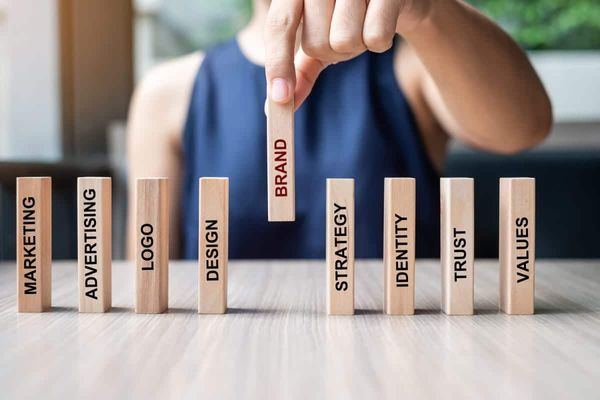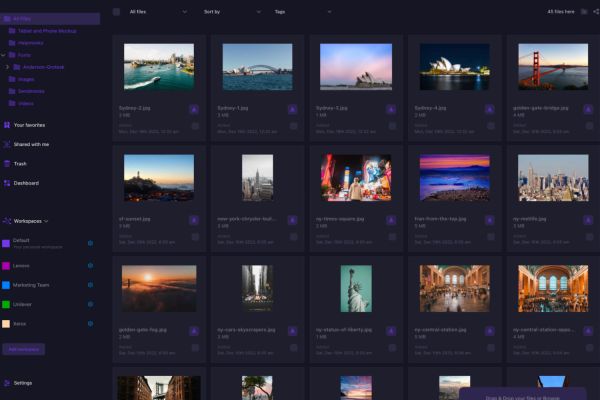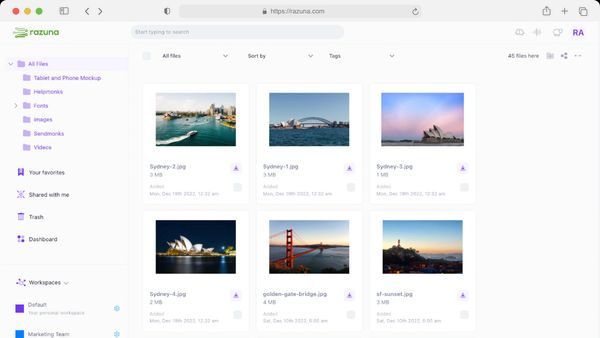
10 Top Enterprise File-Sharing Solutions
Discover the top enterprise file-sharing solutions for secure, efficient collaboration. Learn what to look for in an file-sharing solution and find the best fit.
Read nowDid you know that at $335 billion, Apple is the most valuable brand in the world?
While many may think branding is just a form of marketing, it’s an incredibly powerful tool with real-world value. Branding plays a significant role in helping customers recognize your business but also contributes to building sustainable customer loyalty. This translates directly into more sales, profit, and growth.
Creating a fantastic brand is excellent, but maintaining the brand is just as important. Brand value is something that can change overnight if you’re not careful. This is why brand management is so important and should be understood by businesses of all shapes and sizes.
Interested in learning more about brand management? Here’s a complete guide on everything you need to know about the power of branding and how to manage your brand in 2023.
Branding is a marketing concept that relates to how customers perceive your business, product, or service. This is done through various elements such as how your business operates, your products, or your services' quality.
Brands are often built through messaging. This can be through the design of a business logo, a compelling mission statement, or a consistent theme of colors that appear on all your products. In this way, branding helps give your business a personality in the marketplace.
This personality is more than just how your business or products looks but also includes the customer experience. The way your website looks, the colors you use, and even the tone used in your content all play a part. These elements all fuse to create a feeling for your customers to associate with your business.
Branding can also be used to form and solidify corporate associations. When two companies work together publicly, you may notice that their logos will usually be published together. This helps customers view both businesses together to visualize the association.
A brand is a name, design, symbol, or feature that helps make your business unique and distinguishable. Branding helps to add personality to your brand to help attract customers and the right kind of customers. This is because the brand you build adds character to your products to help set them apart from others on the market.
A brand starts with a name and can include your logo, slogan, mission statement, product design, website design, and even the tone of your written content. Branding is rooted in marketing and is the most effective way to bring your products and services to life.
Branding is an effective identifier within the marketplace. The brand you build for your business adds personality to your products that can help differentiate them from competitors. The imagery associated with your products can improve awareness, allowing customers to spot your products quickly on the shelves.
This way, you can use branding to help align your business within the market. If you want to advertise your products or services to high-income individuals, you can brand your products in that way. The way your product looks, your website is designed, and even the colors you choose can all play a part in aligning your brand.
These elements all work seamlessly to provide your business with a competitive advantage. By using branding and brand messaging, you can communicate with customers before they make their purchases. You can tell them what your business stands for, who it is designed for, and even what kind of experience they can expect if they choose you.
All of this can be achieved through branding and managing your brand effectively.

Building a brand is an essential process for any business. This process starts with what the goals of the business are, along with how the business would like to be perceived. Here’s a quick look at how to build an effective brand for your business, product, or service.
Before making any decisions about your brand, it’s essential to understand who your brand is for. This process includes researching your customers and competitors to see how you can create a brand to capture their attention.
You can analyze competitor brands, social media accounts, and pages targeting your ideal customer. This will let you know what kind of branding works within this demographic. This information can help guide you as you craft a message and look for your business.
Once you have all your information, you can structure your brand messaging. This is where you can put your goals, ambitions, and ethos into words. While your business goals may be complex and complicated, this is where you get to shrink everything down into a simple, elegant, catchy slogan.
Your mission statement and other written content can also be curated to elevate your message. A great way to position your brand is to use the right words in the ideal tone. This will help your message resonate with your target audience.
Last but not least, you can take creative control over your look. This process includes taking everything you have worked on and using it to create vibrant imagery for your business. Most businesses start with a logo, but this imagery includes your color scheme, font choice, product packaging, and website design.
When you choose a specific look, you want everything your business publishes to adhere to that standard. This will help your audience recognize your products and business even when your business name is out of sight.
Branding is an effective marketing tool that can significantly impact your business. This concept adds value to your business in more ways than you may realize. Here are a few key benefits of building and managing a brand that you should know about.
Did you know that the brand you build can have a financial value associated with it? Since branding can significantly influence your company’s revenue, it can have financial value. This way, investing in your brand is investing in the long-term growth of your business.
Brand value is always considered when it comes to buying or selling businesses. The most prominent companies in the world have massive brand values and continue to invest in growing that value. This metric is also linked to brand recognition and the overall reach that your business has within the market.
Brand recognition is how well your customers and potential customers can identify your business, products, or services. This is incredibly important as it gives you a competitive advantage. You will get that sale if a potential customer is looking for a specific product but can only remember your brand.
This is why building a memorable brand for your business is so beneficial. When crafting your brand, you should ensure that your messaging and look are unique. This way, your brand won’t get mixed up with a competitor.
Great businesses need great people. Every business wants to attract top talent that are happy about where they work. When employees are happy, they tend to be more engaged and productive daily.
This way, branding your business the right way can help attract talent. Many big tech companies embrace this concept by offering tons of perks to create a fun and exciting culture at work. The culture is an extension of the brand and helps make working there more attractive.
Creating and maintaining a brand can help you build a strong relationship with your customers. Your brand acts as the personality and identity of your business, allowing customers to get to know you and your products. This relationship leads to loyal customers knowing they can trust your brand in the future.
Loyal customers directly translate into recurring sales for your business. This also means that your business will benefit from word-of-mouth marketing from your happy customers. This way, branding can have a domino effect, growing your business.
Branding can help make your entire business more recognizable. This means that customers and potential customers will already know about you when they view any marketing content you publish. That awareness can help make your marketing more effective.
Since your target audience already knows about your business, they are more likely to take a closer look at your marketing content. Every piece of targeted marketing content can see improved results, from watching your entire ad on YouTube to engaging with social media.

Brand management refers to everything your marketing team does to maintain and grow your brand. As mentioned above, brands are powerful tools that can create immense value for your business. Brand management aims to maintain and use this value to grow the business.
In practical terms, brand management can include a wide variety of tasks. This can range from maintaining an active presence on social media to improving customer support and even creating innovative marketing campaigns.
Brand management also includes evolving the brand. This is essential to keep your brand relevant and modern in an ever-changing economy. The most recent example of this is the rise of TikTok and how brands worldwide have adapted to include short-form video content in their marketing strategies.
Brands don’t just help you stand out; they also add value to your business. The brand you build for your business acts as its personality and can help you attract potential customers. Building a strong brand can also help improve customer loyalty so that customers keep coming back.
While this shows how brand value can translate into revenue for your business, it also shows how important maintaining your brand is. Customers will keep returning if your brand and product meet or exceed their expectations. To keep expectations high, you have to manage your brand actively.
This describes managing a brand as an ongoing, evolutionary process. As we all know, the economy can shift in the blink of an eye. In these situations, your brand must adapt to remain relevant for customers.
If your brand loses visibility or fails to meet customer expectations, you could lose the brand value you once had. This means that brand awareness will decrease, along with the revenue and profit that come with it.
Brand management is also incredibly important when expanding your business. New markets rely on your brand messaging to learn about your business, products, or services. While you may have done the brand marketing in one location, the new market may not have seen that content.
This is why it’s so essential to develop your brand continuously. Sometimes, a new market may require adjusting and evolving your brand. Brand management allows you to adjust and realign your brand to capitalize on these opportunities.
Managing a brand is how you maintain the value that’s associated with your brand. This process includes analyzing and adapting your brand to remain relevant every day. Read on for a complete guide on how to manage your brand efficiently in 2023.
The most important thing you should do when maintaining a brand is to set clear rules. Every brand should have clear rules and parameters on what the brand should be. This can help empower your marketing team to create the right kind of content for the brand.
These rules can be both simple and complex. On the simple side, your rules should include the colors, fonts, and styles you want your brand to use. These rules can also get more complex with your brand's mission, goals, and ambitions in the market.
Creating a checklist is a great way to keep all your marketing content aligned with these rules. This brand checklist can act as a guide for your marketing team when they create content. This checklist can also come in handy when auditing marketing materials before publication.
A brand checklist can also be used to develop innovative templates for your marketing team. These templates can be designed around your brand rules to ensure that every piece of content embodies your brand. This helps guide your team while keeping to the brand's rules.
Your employees play an essential role in both creating and maintaining your brand. Everyone must be on the same page, whether you handle marketing or have an entire team working for you.
When you update the brand or what you want the brand to be, the transition should be seamless. You should always start by talking to your marketing team, so everyone knows the new direction. Having everyone updated before changes take place ensures that there aren’t any mistakes.
If your brand were to change its primary color, the last thing you want is for something to be published with the old colors. Engaging with your marketing team can prevent these issues from ever happening.
Engaging your employees does more than notify them of changes; it develops employee buy-in. This means that your staff can get the opportunity to embrace the new direction before it’s launched. Employee buy-in directly translates to increased productivity, allowing your entire team to work more efficiently.
Another great benefit of engaging with your marketing team is the feedback they can provide. This feedback can help you develop your ideas further to point you in the right direction.
Communication is one of the most essential tools for any business. Effective communication can ensure that your marketing is aligned perfectly when managing a brand. If you plan on making any changes to the design or style of your brand, this should be communicated with employees, partners, and clients.
This gives your partners time to adjust to your new direction and make the necessary changes. If you were to change your logo, having your business partners still advertise the old one is not ideal. This gives the impression that the process was rushed and not planned out in advance.
Whether you have a corner store or a publicly listed company, brand asset management can help you optimize your entire marketing strategy. Almost all modern businesses rely on brand assets that must be managed effectively within the business.
Brand assets are all digital assets your business uses to create, maintain, and grow its brand. These digital assets can range from complex logos to fonts, designs, images, videos, infographics, and brand guidelines. Digital assets can also include written content such as bios, histories, website copy, and templates.
Team members store and access these assets to create and publish marketing content for your brand. This is why managing these assets is so important.
Brand asset management refers to storing, organizing, and securing your brand assets. As mentioned above, brand assets are used by various team members to build and maintain your brand. In this way, it’s essential to manage these assets effectively, making them easy to find whenever needed.

Brand asset management is incredibly important for both small and large businesses. Here’s a quick look at why brand asset management is so essential when managing a brand.
Businesses can create thousands of digital assets in a single year. How easy would it be to find if you ever needed to reuse a single asset? Brand asset management makes this process incredibly simple as it helps centralize and organize all your digital assets.
This means all team members can go to a central location to find and use digital assets. Having a central location that everyone can access saves tons of time.
Marketing is often a high-pressure environment with deadlines all over the place. Organizing your digital assets in a central location helps team members quickly find what they’re looking for. This makes creating and publishing marketing content incredibly efficient.
Brand asset management systems are more than just cloud storage platforms. Every digital asset can include titles, tags, and metadata. This way, the marketing team can intelligently search for what they need in your asset library.
Have you ever lost an email? Imagine if that email had valuable digital assets that you needed for your brand’s marketing campaign. Brand asset management solves this issue by safely storing your digital assets in a safe, secure location.
These platforms also let you organize workflows so specific teams can access different assets. This helps maintain the security and privacy of your business library.
Brand asset management systems ensure you never have to request digital assets through emails again. You must access the asset library if you need a particular logo or image. This lets you securely download the asset without waiting for someone else to email it.
If you’re working with another person, this can save tons of time as they can quickly see the latest version instantly. This reduces the back, and forth that would typically slow down the process.
If you have content that’s been created for a client, brand asset management systems can help. This is because you can share files with clients directly from the system. You don’t need to waste time downloading and sending hundreds of drafts to get feedback.
These platforms let clients see the latest draft and give feedback in the blink of an eye. In addition to saving time, this can make the entire process more effective for everyone involved.
When managing your brand, you should never lose sight of your customers. Even if you’re rapidly expanding your business to new markets, focusing on your customers can help guide you. This helps you maintain your brand and evolve it ideally in every market.
The customer experience is essential to crafting a brand for your business. This is where customer feedback comes in, as it can help you see what’s working. While not all customer feedback will be positive, all customer feedback can help you grow.
Whether you have a good or bad review, you must react quickly. This lets your customer know that you have heard their concern and are dedicated to improving their experience with you. In many cases, this can help retain that customer in the future.
Even if you think it’s just one customer, a bad review can have a massive influence. However, if you react quickly, the bad review becomes a talking point on your brand's greatness.
When marketing your brand, holistic marketing is always the way to go. Even if you’re having fantastic success on one platform, putting all your eggs in one basket is never a good idea. Maintaining a presence on multiple platforms allows for crossover exposure, expanding your reach further.
Digital marketing itself is incredibly diverse. While many people may jump directly to social media marketing, digital marketing includes email marketing and website design. Website design is incredibly important as it’s the most enormous canvas to showcase your brand.
Social media is incredibly limited in what it can offer you. This is because the platform limits your creative ability to a profile picture and individual posts. Regarding website design, there are no limits to what you can create for customers.
This allows you to use the right colors, fonts, styles, and images to portray your brand perfectly. How your website looks plays a significant role in how customers view your brand. However, the way your website operates is just as important.
If your website takes too long to load and is incredibly complicated to navigate, the customer experience will take a hit. In addition, there are marketing strategies you can use to ensure that your website comes up first for people searching for you. This way, your brand can appear above your competitors.
While everyone dreams of expansion, local marketing is often the most effective way to build your brand. This is because local marketing focuses on building your brand slowly over time. There are tons of tools available that help you target your marketing effectively.
This is incredibly important if you have physical locations that you want to promote. As your brand begins to grow, the boundaries will naturally increase. This helps keep every cent you spend on marketing incredibly effective.
Evolution is inevitable even if you have the most successful brand in the world. The global economy evolves incredibly fast, leaving businesses that fail to evolve behind. This is why it’s important to constantly evolve your brand to remain relevant.
Branding is all about the customer. This means that the best feedback you can receive is directly from the customer. This information can help you adjust your brand to be as effective as possible.
Consumer data can help you determine what works and doesn’t. If you have invested in Instagram marketing, but your target audience isn’t on Instagram, the consumer data will show you what platforms they use. This will help you direct your marketing budget to the right place.
While you may think you must run thousands of surveys to access this information, the modern market has evolved. This means you can access incredibly accurate data from how customers interact with you online.
If customers visit your online store but don’t make a purchase, you can see exactly what happened. In most cases, you’ll be able to see precisely what prevented them from completing the sale. This helps inform you of the changes you need to make in the future.
The primary goal of a business is always to grow. This could mean growing your brand awareness, market share, or profits. While growth doesn’t happen overnight, you should always prepare for it.
Preparing your growth business is critical to ensure that you can capitalize on the opportunity. If your marketing content goes viral overnight, you should be able to scale up your business to meet the new demand.
While this is true for business, it’s also valid for managing your brand. As things change, your brand should be able to scale and adapt to the new demand. If one platform seems more effective, it makes sense to scale up your marketing on that platform.
Building a scalable brand allows you to increase brand awareness whenever the opportunity presents itself. There are a few unique ways you can create scalable marketing strategies. One of the easiest ways is to create innovative templates that can be used on multiple platforms.
Having hundreds of templates already designed can ensure that you can rapidly create content. The best part about these templates is that they would have already been made to fit your brand. This means you only need to add the finishing touches before it's ready.
It’s essential to have templates that can work on multiple platforms. This way, you can use the same template and content to post on Facebook, Instagram, and Twitter. Since you don’t have to create individual content for each platform, this saves you time and helps you scale your marketing campaign quickly.

As mentioned above, investing in the right tools to manage your brand is incredibly important. These tools can help you maintain and evolve your brand, adding value to your business. Here's a quick look at the most essential brand management tools you can use.
Building a brand checklist is a great tool that you can use throughout your business. From packaging to marketing and advertising, having a brand checklist handy can ensure that everything fits your brand. This checklist can evolve but should be referred to before anything gets published or posted.
A brand checklist can vary from a simple style guide to a complete mission guide. The style guide can highlight brand rules associated with how content is presented. This checklist can include what fonts should be used and what colors should be prioritized.
The mission guide can take a more comprehensive approach. This can highlight what your brand stands for and what the goals of the brand are. This can help you evaluate your content to ensure that your publishing aligns with the brand's aims.
The brand checklist can be used during content creation and quality control processes. This is because the checklist can give the marketing department a rough guide on what content they should create. The checklist can also be used after creating content to evaluate whether each point has been achieved.
In the modern economy, most marketing and business activities are done digitally. Whether your business is a small corner store or an international conglomerate, digital assets can pile up and need to be managed. Organizing and managing these assets can help you locate and share them efficiently with team members, management, and clients.
Digital Asset Management (DAM) systems are designed to solve this issue. These systems work as dynamic, intelligent storage platforms that let you upload and organize your digital assets. These assets can range from logos to images, videos, templates, and other forms of branded content.
While you may think you can use any cloud-based storage platform to do the job, digital asset management systems take this to a new level. This is because the platform itself is designed to optimize your workflow. DAMs don’t just act as storage but offer other features to help support your marketing and branding teams.
In addition to hosting a secure media library, you can organize your digital assets according to custom labels, keywords, and metadata. This lets you search for items intelligently and even filter assets for specific client workspaces. This way, the platform is always ready with the content you need precisely when you need it.
Razuna also adds more functionality by allowing you to edit assets within their platform. You can crop, cut, rotate, filter, and even add text to assets without using other applications. These features are designed to save you time so your marketing team can work as effectively as possible.
Digital marketing is incredibly effective in the modern economy. However, maintaining a social media presence on numerous platforms at the same time can be a daunting task. Brand templates are a great way to save time while sticking to your brand guidelines.
Brand guidelines and checklists ensure that every post and every marketing initiative is held to a certain standard. Having templates designed in advance can help ensure that every box is ticked, even in time-sensitive situations.
This makes creating marketing materials more manageable and more efficient. Instead of creating everything from scratch, you can use a branded template that meets your brand requirements. This helps maintain the standard while saving you tons of time.
Innovative apps and platforms are available to help you create these templates. You can create as many templates as you want, allowing you to have creative freedom with every post still. Most companies have a range of templates created according to their brand needs but still give creative control to the marketing team.
This way, the marketing team uses the template as a starting point and a guide.
Managing a brand is essential for both small and large businesses. Creating and maintaining a brand can have a significant impact on your business. From building brand value to improving customer loyalty, brand marketing can have a massive effect on the success of your business.
While there are various strategies, you can implement to manage and grow your brand, having the right tools makes it all possible. In the modern economy, having a centralized place to store and share digital assets is essential.
Click here to learn more about investing in a brand asset management platform.

Discover the top enterprise file-sharing solutions for secure, efficient collaboration. Learn what to look for in an file-sharing solution and find the best fit.
Read now
What is digital asset storage? This guide to digital asset storage has all the answers. Learn how to implement digital asset storage for all your teams.
Read now
All files that your business uses is a type of digital asset. This guide explains the various types, what makes them crucial, and how best to manage them.
Read now
A digital asset management strategy is essential for your brand. This guide explores how to maximize your brand's potential with this powerful combination.
Read now
(each free accounts comes with 500 GB space)
